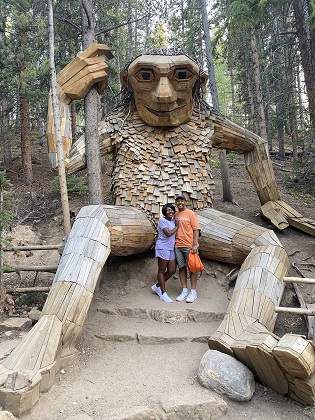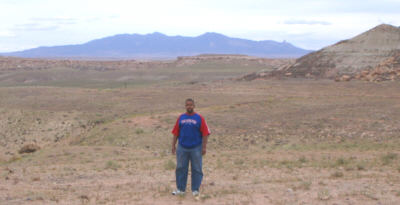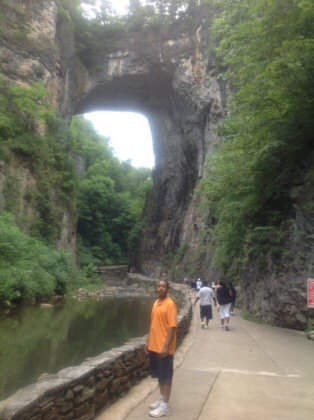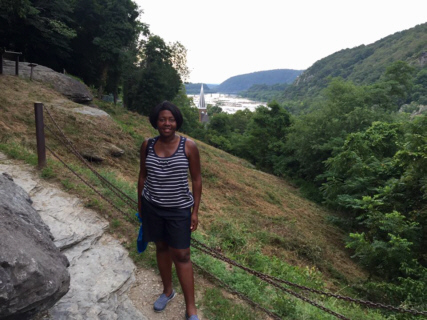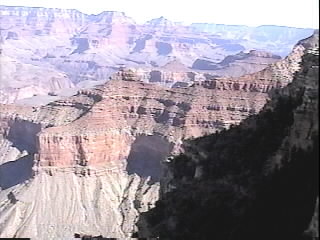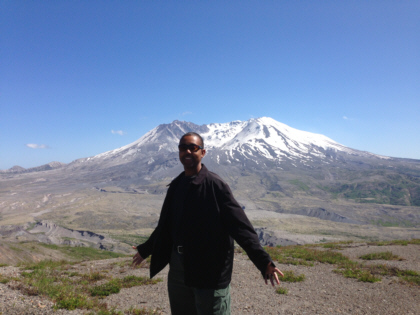Tuesday
Jelly Belly Factory Tour - Surprise, Traci!
Tuesday was the day of our vacation to which I was really looking forward. Few things in life bring a smile to Traci's face like a bag of Jelly Belly gourmet jelly beans. When I found out a month before our trip that there is a Jelly Belly factory in Wisconsin that gives free tours, I decided to make this a surprise stop in our sightseeing itinerary.
The huge grin that came across Traci's face when we drove into the parking lot was worth the 2.5-hour drive we had done that morning to get there. For our tour, we boarded a miniature train called the Jelly Belly Express. No jelly beans or any other candy is made at the Wisconsin site. It is a distribution warehouse. However, since the warehouse handles food products, the FDA (Food and Drug Administration) requires that all people on the warehouse floor wear a hat. If you don't have one - no problem. You'll be given a paper Jelly Belly hat.
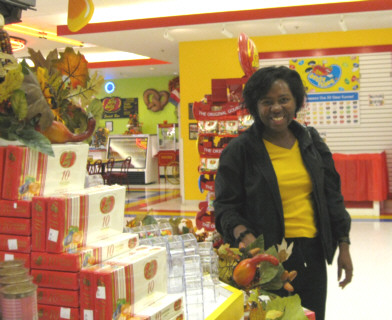
That grin was worth the 2.5-hour drive.
The train drove us around the warehouse floor for 30 minutes stopping at stations where we watched videos of the history of Jelly Belly and their candy-making process. President Ronald Reagan was a big fan of Jelly Belly jelly beans. He used them to help kick his smoking habit. He was known to start his meetings by passing around a jar of jelly beans. There are autographed photos and other items from President Reagan enclosed in a glass case in the candy store.
We rode by some cool mosaics made of thousands of jelly beans. No pictures are allowed during the tour but fortunately there are several of these artistic works on display before the tour begins. These can be photographed.
At the conclusion of the tour, each person is given a free bag of jelly beans. We then spent time looking around in the store. There is a sample bar where you can taste any of the products Jelly Belly makes. Jelly Belly prides themself on making their jelly bean flavors as real as possible. It took them 10 years to develop the right combination of flavors to produce their kiwi-flavored bean.
There are some flavors I wish they hadn't made. Jelly Belly's BeanBoozled jelly beans are gag flavors such as skunk spray, boogers, vomit, and rotten egg. I got up the nerve, with some encouragement from Traci, to try the skunk spray jelly bean. One bite of this atrocious piece of candy filled my nostrils with the pungent smell of skunk spray - yuck! One of the guys behind the counter offered me the toothpaste-flavored bean to help get the smell and taste out of my mouth. He then offered me the buttered popcorn flavored jelly bean. As soon as I put it in my mouth, the jokester told me he had given me the rotten egg flavor...Too late...Crunch...Ewww!!! Biting that jelly bean filled my nostrils with the stench of rotten eggs and garbage. This has to be the worst-tasting candy in the world. Even worse was that it took several minutes to get that horrible taste out of my mouth. By this time, Traci and the guys behind the counter were having a good laugh as I contorted my face in response to the assault on my taste buds.
We spent quite a while in the candy store as Traci loaded up on Jelly Belly merchandise including a sweatshirt. She also bought a bag of Belly Flops. These are the jelly beans that failed the quality assurance test because of their size or shape. There is not much of a discount on the products sold at this site. We managed spend $68. The Jelly Belly factory was Traci's favorite attraction of our week in Wisconsin.
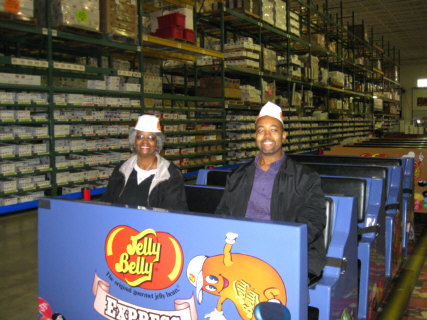
ready for the tour
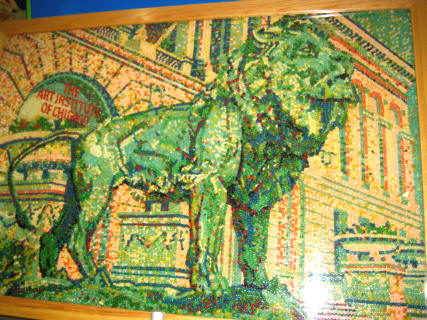
mosaic made from thousands of jelly beans
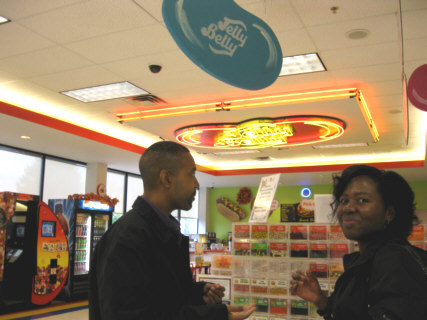
tasting at the sample bar
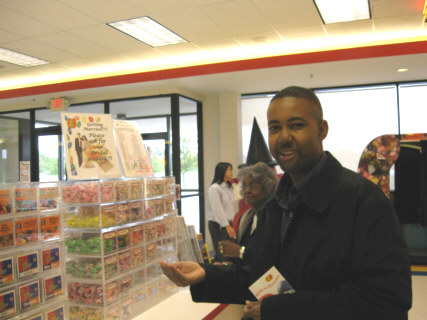
rotten egg-flavored jelly bean - Yuck!!!
Old World Wisconsin - Wisconsin's Melting Pot
From the Jelly Belly Factory, we drove about an hour northwest to the town of Eagle. We were there to see Old World Wisconsin. It is a living museum that reminded me of Colonial Williamsburg. However, instead of America's colonial period, Old World Wisconsin focuses mainly on Wisconsin's immigrant farm communities of the mid to late 1800's. The employees are dressed in period costumes and go about typical chores of that era as they interact with visitors.
As we were getting out of the car, a nice lady came across the parking lot to greet us and tell us they were operating on their fall hours - meaning they'd be closing at 3 PM. She told us it normally takes from 4 to 6 hours to see the whole place. It was already 1 PM. She handed us a map and gave us advice on how to make the most of our two hours.
We purchased our tickets at the souvenir shop and headed downstairs to view a 17-minute orientation film. Old World Wisconsin is huge. It contains 65 authentic historical buildings that were moved from all regions of the state and re-assembled here in the recreated ethnic farmstead communities of the 1800's. The buildings are connected by 6 miles of dirt trails that lead through fields and woods. For convenience, there are hop-on hop-off trams that arrive at various stops every 10 minutes or so.
Each area of Old World Wisconsin recreates a typical farmstead of an ethnic community. These are: German, African American, Polish, Norwegian, Danish, Finnish and Yankee (American-born citizen that migrated from the East Coast). After viewing the orientation film, we made our way to the Crossroads Village. No particular ethnic group is represented here. We wandered into St. Peter's Church, Wisconsin's first Catholic Church. The costumed guide told us stories about the church and how the German and Irish immigrants temporarily put aside their grudges to build this place of worship together. She also played a hymn on the church's pump organ built in 1870. We wandered into other buildings in the village such as the Hafford House of 1885 where we learned about the Irish widow who washed clothes for a living and the Grotelueschen Blacksmith Shop where we watched a guide hammering out hot metal to form horseshoes.
We caught the tram up the dirt road to the African American community. There were no guides there that day so we read the information posted in the Pleasant Ridge Chapel. It told of the Shepherd Family who was among the freed blacks and escaped slaves that began settling in Pleasant Ridge in 1850. We also had a peek inside their rustic United Brethren Church.
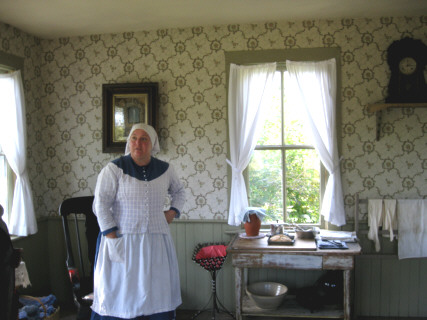
1885 home of a widowed washerwoman

walking to United Brethren Church in the African American Area

black kitchen in the German Schultz Farmhouse
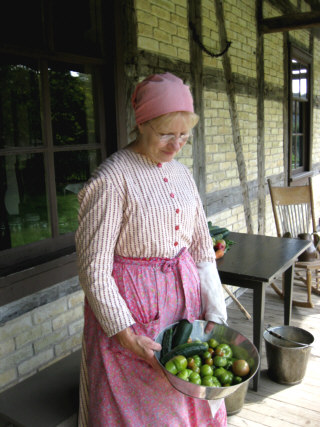
vegetables from one of the German farms
The German Area was our last stop before we ran out of time. This area has three farms containing gardens, cattle, horses, and chickens. We interacted with the guides in each of the three houses of the communities. The Schultz farmhouse was the most interesting to me because of its black kitchen. The black kitchen gets its name from the smoke stains on the wall. In those days, a fire had to be burning almost constantly for cooking and hot water. Despite the tall chimney we peered up at, the women of that period had short life expectancies because of the fire risk and black lung disease. We headed out to the barn to talk with the guide there but got cut short because two of his chickens had escaped into the woods and it was almost closing time.
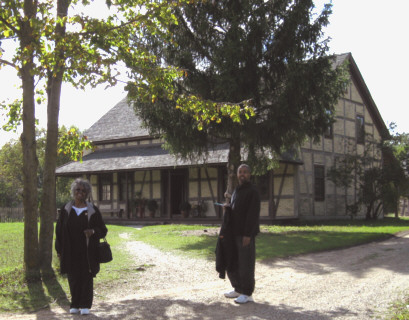
Koepsell Farmhouse - 1858 half-timbered German architecture

stretching after all the walking
We took the tram back to the main building stopping along the way to pick up the rest of the costumed guides as their work day was ending. I had really enjoyed Old World Wisconsin and was sorry we did not get a chance to visit the other ethnic communities in the park. Fortunately, we would visit Wisconsin's Norwegian and Swiss communities the next day during our sightseeing outing in the southwestern part of the state.
Milwaukee - Dining and Dashing
Since we were already on the eastern side of the state due to our Old World Wisconsin visit, we decided to drive about an hour northeast to have dinner in Wisconsin's largest city, Milwaukee. That name always reminds me of Laverne & Shirley and beer commercials. As we drove around this rather old-looking city, Traci was impressed with the number of runners she saw. We parked in the Historic Old World 3rd Street District. We had a look around in the Wisconsin Cheese Mart. It has the world's largest selection of Wisconsin cheeses. We were able to sample some - including the cheese fudge. It tasted more like dessert than cheese.
We then walked across one of the bridges along Riverwalk. There was a rowing team out practicing in the cold weather and ducks swimming around.
We finished off our short Milwaukee visit with a very nice seafood dinner at Molly Cool's Seafood Tavern. At $75 for the three of us, this was our most expensive meal of the week - not too bad. The nice waiter then gave us a coupon and knocked $10 off the bill.
We had a 2-hour drive back to the Dells that night. We had been on the go since 6:30 AM and I was feeling it when we got back to the condo. I went straight to bed. The next day would be just as busy.
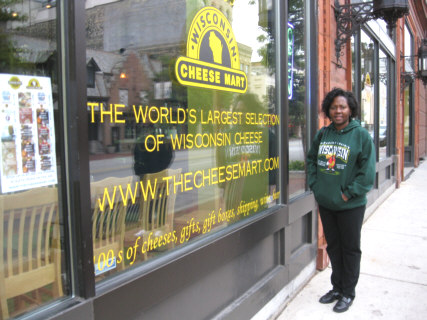
"Say cheese!"

Look what Mom found in the Wisconsin Cheese Mart.
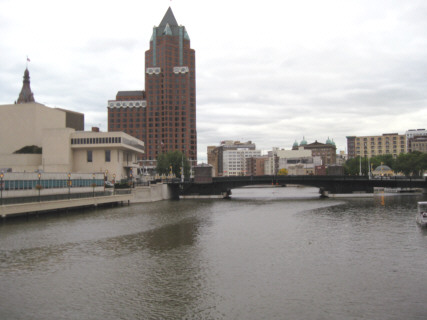
strolling Riverwalk
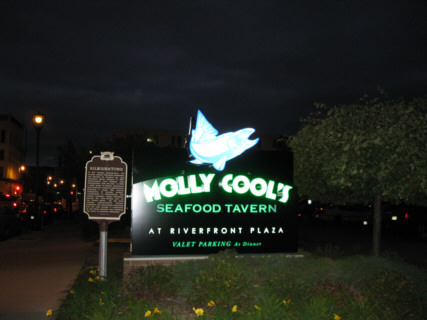
We had a very nice seafood dinner here.
